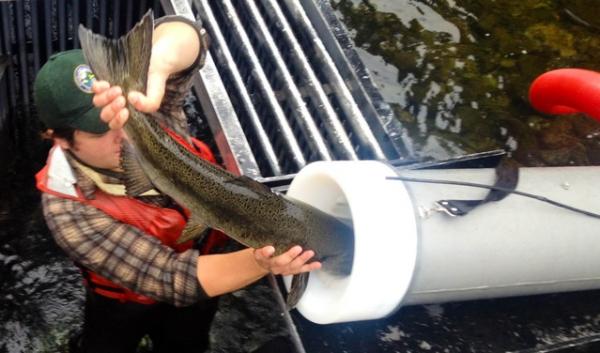
By: Aaron Kunz, Northwest Public Radio
WASHOUGAL, Wash. — Salmon may soon have a faster way to make it around dams. There’s a new technology that’s helping to transport hatchery fish in Washington. It’s called the salmon cannon — yes, you read that right.
First, let’s set the record straight: there’s not really an explosion. But the salmon cannon does propel fish from one spot to another.
That was demonstrated Tuesday, when the salmon cannon transported fish from southwest Washington’s Washougal River to a nearby hatchery. The goal is to make the move easier on the fish, in three steps.
Watch the video: The Salmon Cannon In Action
First, the cannon: A long, flexible tube stretches out of the river. At one end, crew members wade into the river. They heave up a 30-pound fall chinook salmon and lift it into the tube.
The fish is sucked up the 110-foot tube at about 22 miles per hour. And then it plops out into a truck filled with water and swims around.
“It’s almost magical the way the fish will move through the system. It’s like a slip and slide, going uphill,” said Vince Bryan, the CEO of Seattle-based Whooshh Innovations, the company that’s engineering the salmon cannon.
After the truck is filled with about 100 fish, they’ll be driven to a nearby hatchery. These fall chinook salmon will be used to help breed next year’s hatchery runs for the Washington Department of Fish and Wildlife.
Eric Kinne, the department’s hatchery reform coordinator for southwest Washington, said the fish are less stressed with the salmon cannon. Before this, salmon were transported with a forklift and tote container.
“We would have to fill it with water and put the fish in. Then we’d have to turn it around and haul it up to the landing area and then dump them into a truck. It was very hard on fish,” Kinne said.
The salmon cannon technology was first used as a way to transport fruit. Bryan said the hope is that it will one day transport fish up and over large dams on the Columbia and Snake rivers.
“We’ve actually had even early discussions with getting fish over dams like the Grand Coulee. We’re starting out much smaller than that, obviously,” Bryan said.
It’s also a way to keep hatchery fish out of the natural spawning grounds of wild fish, Kinne said.
The unit demonstrated Tuesday cost about $150,000, he said.
So does the salmon cannon hurt the salmon? Kinne said the state Department of Fish and Wildlife tested out the salmon cannon with steelhead before putting it into action. They compared fish transported with the cannon to fish transported by hand.
“We held them for six weeks to see if there was any difference in mortality, or difference in condition of fish, and no. Everything was really good,” Kinne said.
Every once in awhile, a small salmon will get stuck in the tube, which is designed to operate with fish 15 to 30 pounds. Crews can then send either a water-soaked sponge or a larger salmon to help move it up the tube.
Yakama Nation tribal fisheries are also testing out a salmon cannon in central Washington.
Story and audio by Courtney Flatt. Video by Aaron Kunz and Courtney Flatt.
